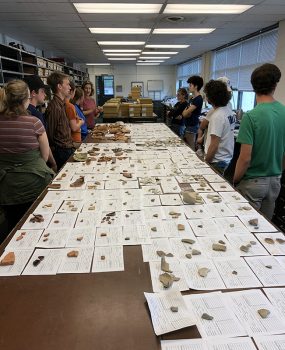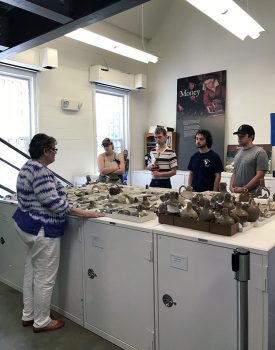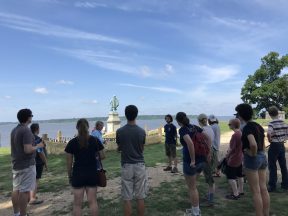Back to Dispatches from Field School
Field School 2018 – Week 5, Part 2
Eva Miller — St. Mary’s College of Maryland
“Field Trip: Colonial Williamsburg and Jamestown”

Associate Curator Kelly Ladd explains the process of mending ceramic vessels back together in the Colonial Williamsburg Foundation’s Archaeology Lab
This week we got a chance to see not only other early colonial sites here on the East Coast, but also how other archaeology programs operate thanks to a field trip to Colonial Williamsburg and Jamestown. I have been to Colonial Williamsburg before on family vacations, but this trip offered a chance to see a side of it I had never experienced before: the labs! The Colonial Williamsburg Foundation has been conducting archaeological excavations since the 1920s, when they began “cross-trenching,” or digging long lines of parallel trenches, looking for the brick foundations of buildings along Duke of Gloucester Street. Although this method has long since been replaced with more scientific digging methods, this long history of excavation means they have an extensive collection of artifacts. It was interesting to see different, later ceramic types than those we usually find and well-preserved organics, like a leather belt and shoes, that have been recovered from filled-in wells. Organics like that can be well-preserved by the consistently damp and oxygen-free environment old wells provide. Our guide, Associate Curator Kelly Ladd, told us about digging up a holly leaf from the 18th century that was still green, only for it to shrivel to dust as soon as it was exposed to oxygen for the first time in hundreds of years. Unfortunately, wells were not dug here at St. Mary’s due to the high number of fresh water springs.

Jamestown’s Curator of Collection Merry Outlaw shares exciting artifact stories with our field school students
Jamestown, the first permanent English settlement in America and the capital of Virginia until it was moved to Williamsburg, was also interesting. Although the exact location of the early fort was only located in 1994 (it was long believed to be on a part of the island that is now underwater), they have already built up an impressive collection of artifacts. In their lab we got to see the process artifacts follow, from initial cleaning with either water or air abrasion to study and storage in a controlled environment. Curator of Collections Merry Outlaw showed us a piece of an early tobacco pipe with Arabic characters on it believed to be from the Ottoman Empire, the only one of its kind found so far in Virginia.

Jamie May, Director of Museums at Jamestown, describes some of the many excavated sites within James Fort
Currently, the Jamestown team are conducting excavations inside of the reconstructed brick church. They have found evidence of the earlier wooden church that stood there, which they feared was lost, as well as one of the earlier burials. Nearby, there is a post-in-the-ground church that they excavated a few years ago where an unusual burial was found. Four men were buried at the front of the church, one of whom was found with a metal box; special imaging has allowed them to see inside of the box without opening it, revealing lumps of lead and human bone. It is believed to be a reliquary, which would have held holy water in a vial sealed with the lead, and the bones of a saint. This is interesting as Jamestown was a Protestant colony, where Catholicism was banned by law, and yet an apparently prominent member of the community was buried in the Protestant church with a Catholic relic. It was interesting to see these different sites, and surprising to me that an important Catholic artifact like that would be found at Jamestown!

